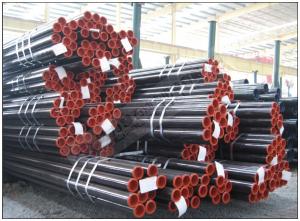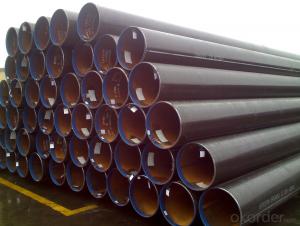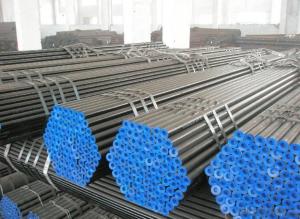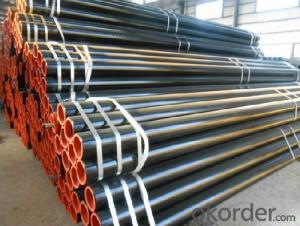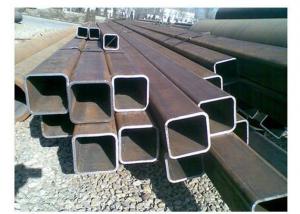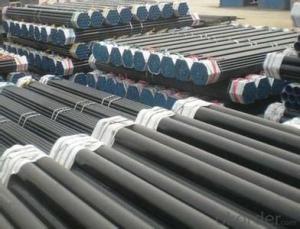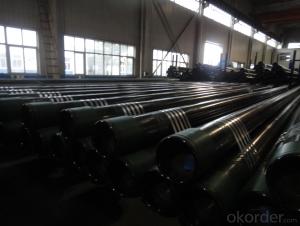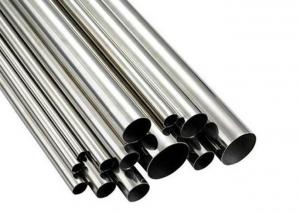Oil Country Tubular Goods
- Loading Port:
- Tianjin
- Payment Terms:
- TT OR LC
- Min Order Qty:
- -
- Supply Capability:
- 20000ton m.t./month
OKorder Service Pledge
Quality Product, Order Online Tracking, Timely Delivery
OKorder Financial Service
Credit Rating, Credit Services, Credit Purchasing
You Might Also Like
Oil Country Tubular Goods
eywords:API 5CT Steel Pipe, J55,K55,L80,N80Q,C90,T95,P110 Oil/Petroleum Casing Pipe, OCTG
1) Grade: J55,K55,L80,N80Q,C90,T95,P110
2) Size: 4 1/2", 5", 5 1/2", 6 5/8", 7", 7 5/8", 9 5/8", 10 3/4", 13 3/8", 16", 18 5/8", 20"
3) Wall thickness: 5.21 - 16.13 mm
4) Thread type: STC, LTC, BTC
5) Length: R1,R2,R3
6) All our casings accord with API 5CT standard, and we get the right to use the API 5CT LOGO.
| Size Destination | Weight Destination | Outside Diameter | Wall Thickness | Type of End Finish | ||||||
| Grade | ||||||||||
| kg/m | in | mm | in | mm | J55 K55 | L80 | N80 | C90 T95 | P110 | |
| 4 1/2 | 9.50 | 4.500 | 114.3 | 0.205 | 5.21 | PS | - | - | - | - |
| 10.50 | 0.224 | 5.69 | PSB | - | - | - | - | |||
| 11.60 | 0.250 | 6.35 | PSLB | PLB | PLB | PLB | PLB | |||
| 13.50 | 0.290 | 7.37 | - | PLB | PLB | PLB | PLB | |||
| 15.10 | 0.337 | 9.56 | - | - | - | - | PLB | |||
| 5 | 11.50 | 5.00 | 127.00 | 0.220 | 5.59 | PS | - | - | - | - |
| 13.00 | 0.253 | 6.43 | PSLB | - | - | - | - | |||
| 15.00 | 0.296 | 7.52 | PSLB | PLB | PLB | PLBE | PLB | |||
| 18.00 | 0.362 | 9.19 | - | PLB | PLB | PLBE | PLB | |||
| 21.40 | 0.437 | 11.10 | - | PLB | PLB | PLB | PLB | |||
| 23.20 | 0.478 | 12.14 | - | PLB | ||||||
| 24.10 | 0.500 | 12.70 | - | PLB | ||||||
| 5 1/2 | 14.00 | 5.500 | 139.7 | 0.244 | 6.20 | PS | - | - | - | - |
| 15.50 | 0.275 | 6.98 | PSLB | - | - | - | - | |||
| 17.00 | 0.304 | 7.72 | PSLB | PLB | PLB | PLBE | PLB | |||
| 20.00 | 0.361 | 9.17 | - | PLB | PLB | PLBE | PLB | |||
| 23.00 | 0.415 | 10.54 | - | PLB | PLB | PLBE | PLB | |||
| 6 5/8 | 20.00 | 6.625 | 168.28 | 0.288 | 7.32 | PSLB | - | - | - | - |
| 24.00 | 0.352 | 8.94 | PSLB | PLB | PLB | PLBE | PLB | |||
| 28.00 | 0.417 | 10.59 | - | PLB | PLB | PLBE | PLB | |||
| 32.00 | 0.475 | 12.06 | - | PLB | PLB | PLBE | PLB | |||
| 7 | 17.00 | 7.00 | 177.80 | 0.231 | 5.87 | - | - | - | - | - |
| 20.00 | 0.272 | 6.91 | PS | - | - | - | - | |||
| 23.00 | 0.317 | 8.05 | PSLB | PLB | PLB | PLBE | - | |||
| 26.00 | 0.362 | 9.19 | PSLB | PLB | PLB | PLBE | PLB | |||
| 29.00 | 0.408 | 10.36 | - | PLB | PLB | PLBE | PLB | |||
| 32.00 | 0.453 | 11.51 | - | PLB | PLB | PLBE | PLB | |||
| 35.00 | 0.498 | 12.65 | - | PLB | PLB | PLBE | PLB | |||
| 38.00 | 0.540 | 13.72 | - | PLB | PLB | PLBE | PLB | |||
| 7 5/8 | 24.00 | 7.625 | 193.68 | 0.300 | 7.62 | - | - | - | - | - |
| 26.40 | 0.328 | 8.33 | PSLB | PLB | PLB | PLBE | PLB | |||
| 29.70 | 0.375 | 9.52 | - | PLB | PLB | PLBE | PLB | |||
| 33.70 | 0.430 | 10.92 | - | PLB | PLB | PLBE | PLB | |||
| 39.00 | 0.500 | 12.70 | - | PLB | PLB | PLBE | PLB | |||
| 42.80 | 0.562 | 14.27 | - | PLB | PLB | PLB | PLB | |||
| 45.30 | 0.595 | 15.11 | - | PLB | PLB | PLB | PLB | |||
| 47.10 | 0.625 | 15.88 | - | PLB | PLB | PLB | PLB | |||
| 8 5/8 | 24.00 | 8.625 | 219.08 | 0.264 | 6.71 | PS | - | - | - | - |
| 28.00 | 0.304 | 7.72 | - | - | - | - | - | |||
| 32.00 | 0.352 | 8.94 | PSLB | - | - | - | - | |||
| 36.00 | 0.400 | 10.16 | PSLB | PLB | PLB | PLBE | PLB | |||
| 40.00 | 0.450 | 11.43 | - | PLB | PLB | PLBE | PLB | |||
| 44.00 | 0.500 | 12.70 | - | PLB | PLB | PLBE | PLB | |||
| 49.00 | 0.557 | 14.15 | - | PLB | PLB | PLBE | PLB | |||
| 9 5/8 | 32.30 | 9.625 | 244.48 | 0.312 | 7.92 | - | - | - | - | - |
| 36.00 | 0.352 | 8.94 | PSLB | - | - | - | - | |||
| 40.00 | 0.395 | 10.03 | PSLB | PLB | PLB | PLBE | - | |||
| 43.50 | 0.435 | 11.05 | - | PLB | PLB | PLBE | PLB | |||
| 47.00 | 0.472 | 11.99 | - | PLB | PLB | PLBE | PLB | |||
| 53.50 | 0.545 | 13.84 | - | PLB | PLB | PLBE | PLB | |||
| 58.40 | 0.595 | 15.11 | - | PLB | PLB | PLB | PLB | |||
| 10 3/4 | 32.75 | 10.75 | 273.05 | 0.279 | 7.09 | - | - | - | - | - |
| 40.50 | 0.350 | 8.89 | PSB | - | - | - | - | |||
| 15.50 | 0.400 | 10.16 | PSB | - | - | - | - | |||
| 51.00 | 0.450 | 11.43 | PSB | PSB | PSB | PSBE | PSB | |||
| 55.50 | 0.495 | 12.57 | - | PSB | PSB | PSBE | PSB | |||
| 60.70 | 0.545 | 13.84 | - | - | - | PSBE | PSB | |||
| 65.70 | 0.595 | 15.11 | - | - | - | PSB | PSB | |||
| 13 3/8 | 48.00 | 13.375 | 339.73 | 0.330 | 8.38 | - | - | - | - | - |
| 54.50 | 0.380 | 9.65 | PSB | - | - | - | - | |||
| 61.00 | 0.430 | 10.92 | PSB | - | - | - | - | |||
| 68.00 | 0.480 | 12.19 | PSB | PSB | PSB | PSB | PSB | |||
| 72.00 | 0.514 | 13.06 | - | PSB | PSB | PSB | PSB | |||
| 16 | 65.00 | 16 | 406.40 | 0.375 | 9.53 | - | - | - | - | - |
| 75.00 | 0.438 | 11.13 | PSB | - | - | - | - | |||
| 84.00 | 0.495 | 12.57 | PSB | - | - | - | - | |||
| 109.00 | 0.656 | 16.66 | P | P | P | - | P | |||
| 18 5/8 | 87.50 | 18.625 | 473.08 | 0.435 | 11.05 | PSB | - | - | - | - |
| 20 | 94.00 | 20 | 508.00 | 0.438 | 11.13 | PSLB | - | - | - | - |
| 106.50 | 0.500 | 12.70 | PSLB | - | - | - | - | |||
| 133.00 | 0.635 | 16.13 | PSLB | - | - | - | - | |||

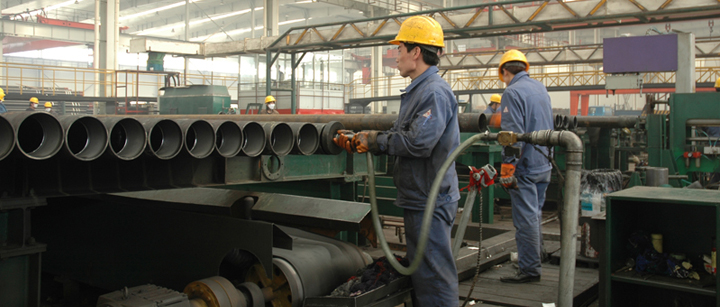
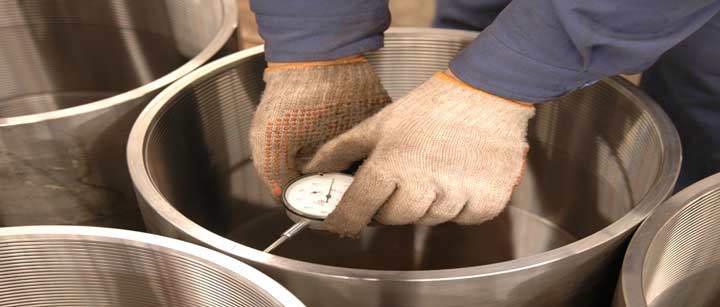

- Q: What are the different types of supports used for aboveground steel pipes?
- There are several types of supports used for aboveground steel pipes, including pipe hangers, pipe clamps, pipe shoes, and pipe saddles. These supports are designed to provide stability and prevent excessive movement or sagging of the pipes. They help distribute the weight of the pipes evenly and ensure proper alignment and support throughout their length.
- Q: What are the different methods of inspecting steel pipes for defects?
- There are several methods of inspecting steel pipes for defects, including visual inspection, magnetic particle inspection, ultrasonic testing, radiographic testing, and eddy current testing. Each method has its own advantages and limitations, and the choice of inspection method depends on factors such as the type of defect being searched for, the size and shape of the pipe, and the desired level of accuracy and sensitivity.
- Q: How do you calculate the pipe volume flow rate for steel pipes?
- In order to determine the volume flow rate of steel pipes, one must take into account the diameter of the pipe and the velocity of the fluid. The formula utilized in this calculation is Q = A * V, where Q represents the volume flow rate, A denotes the cross-sectional area of the pipe, and V represents the fluid velocity. To initiate the process, the cross-sectional area of the pipe must be determined. In the case of a circular pipe, the formula A = π * r² can be employed, where A signifies the area and r denotes the radius of the pipe. If the diameter of the pipe is provided, dividing it by 2 will yield the radius. Subsequently, the fluid velocity must be established. This can be accomplished by directly measuring the velocity using a flowmeter or by calculating it based on the properties of the fluid and the pressure drop across the pipe using the Bernoulli equation or other suitable equations. Once the cross-sectional area and fluid velocity have been determined, they can be multiplied together to ascertain the volume flow rate. It is important to maintain consistent units throughout the calculation. For instance, if the area is expressed in square meters and the velocity is in meters per second, the resulting volume flow rate will be in cubic meters per second. It is worth noting that this calculation assumes the fluid to be incompressible and flowing steadily through the pipe. If there are alterations in the fluid properties or flow conditions, additional considerations may need to be taken into account in order to accurately calculate the volume flow rate.
- Q: What are the factors to consider when designing a steel pipe system?
- When designing a steel pipe system, several factors need to be considered to ensure its functionality, durability, and efficiency. These factors include: 1. Pressure and temperature requirements: Determining the maximum pressure and temperature that the steel pipe system will be exposed to is crucial. This information is essential for selecting the appropriate pipe material, thickness, and jointing method to withstand the system's operating conditions. 2. Pipe material: Choosing the right material for the steel pipe system is important. Factors such as corrosion resistance, strength, and cost should be considered. Common materials for steel pipes include carbon steel, stainless steel, and alloy steel. 3. Pipe size and thickness: Calculating the adequate pipe size and wall thickness is essential to ensure the required flow rate and pressure drop within the system. The pipe size affects the system's efficiency and must be chosen based on the anticipated flow rates and pressure losses. 4. Support and anchoring: Proper support and anchoring are critical to prevent sagging, movement, and stress on the steel pipe system. The design should consider the weight of the pipes, the fluid being transported, and any external forces that may act on the system. 5. Expansion and contraction: Steel pipes expand and contract with temperature variations, causing stress on the system. Expansion joints or loops should be incorporated to allow for thermal growth and contraction, preventing damage and distortion. 6. Fluid compatibility: Understanding the properties of the fluid being transported, such as corrosiveness, viscosity, and potential for sedimentation or scaling, is important in selecting the appropriate pipe material and protective coatings or linings. 7. Accessibility and maintenance: Consideration should be given to the accessibility of the system for installation, inspection, and maintenance purposes. Proper access points, valves, and fittings should be included in the design to allow for easy maintenance and repairs. 8. Environmental factors: The steel pipe system may be exposed to various environmental conditions, such as extreme temperatures, humidity, or corrosive substances. These factors should be considered when selecting the pipe material, protective coatings, and insulation. 9. Regulatory compliance: Compliance with applicable industry standards, codes, and regulations is essential. The design should adhere to safety guidelines and applicable building codes to ensure the pipe system's integrity and longevity. 10. Cost consideration: Finally, the overall cost of the steel pipe system, including material, installation, maintenance, and energy consumption, should be taken into account. Balancing cost-effectiveness with performance requirements is crucial in achieving an efficient and economical design. By considering these factors, engineers and designers can create a steel pipe system that is suitable for its intended purpose, ensuring its longevity, reliability, and safety.
- Q: How are steel pipes used in the oil and gas industry?
- Steel pipes are widely used in the oil and gas industry for various purposes. They are primarily used for transporting and distributing oil and gas from extraction sites to refineries and end consumers. Steel pipes are also used in drilling operations, where they are utilized as casing and tubing to extract oil and gas from wells. Additionally, steel pipes are employed in the construction of storage tanks, pipelines, and other infrastructure required for the production, processing, and transportation of oil and gas. Overall, steel pipes play a crucial role in ensuring the efficient and safe operation of the oil and gas industry.
- Q: What is the importance of corrosion resistance in steel pipes?
- The importance of corrosion resistance in steel pipes is significant as it helps to extend the lifespan of the pipes, ensures their structural integrity, and maintains the quality of the fluid or gas being transported. Corrosion can lead to pipe failures, leaks, and contamination of the contents, resulting in costly repairs, environmental hazards, and potential safety risks. Therefore, incorporating corrosion-resistant properties in steel pipes is crucial for their long-term performance, durability, and overall efficiency.
- Q: Can steel pipes be used for conveying slurry and slurries?
- Yes, steel pipes can be used for conveying slurry and slurries. Steel pipes are known for their durability, high strength, and resistance to wear and corrosion, making them suitable for transporting abrasive materials like slurry. Additionally, steel pipes can handle high pressures and temperatures, making them reliable for conveying slurries in various industries such as mining, construction, and wastewater treatment.
- Q: Are steel pipes resistant to chemicals and corrosion?
- Yes, steel pipes are generally resistant to chemicals and corrosion.
- Q: What's the difference between a rectangular tube and a rectangular steel tube?
- The classification of rectangular tube: steel pipe seamless steel pipe and welded steel pipe (tube) hot-rolled seamless tube, seamless tube, seamless tube, welded tube extrusion. The welded square pipe is divided into two parts:(a) according to the process of arc welding - resistance welding tube, square tube (high frequency and low frequency), welding square tube, welding square tube furnace (b) according to the weld - welded square tube, spiral welded pipe.
- Q: How are steel pipes joined together?
- Steel pipes are commonly joined together using various welding techniques, such as arc welding, butt welding, or socket welding. Additionally, other methods like threaded connections, flanges, or mechanical couplings can be used for joining steel pipes.
Send your message to us
Oil Country Tubular Goods
- Loading Port:
- Tianjin
- Payment Terms:
- TT OR LC
- Min Order Qty:
- -
- Supply Capability:
- 20000ton m.t./month
OKorder Service Pledge
Quality Product, Order Online Tracking, Timely Delivery
OKorder Financial Service
Credit Rating, Credit Services, Credit Purchasing
Similar products
Hot products
Hot Searches
Related keywords
